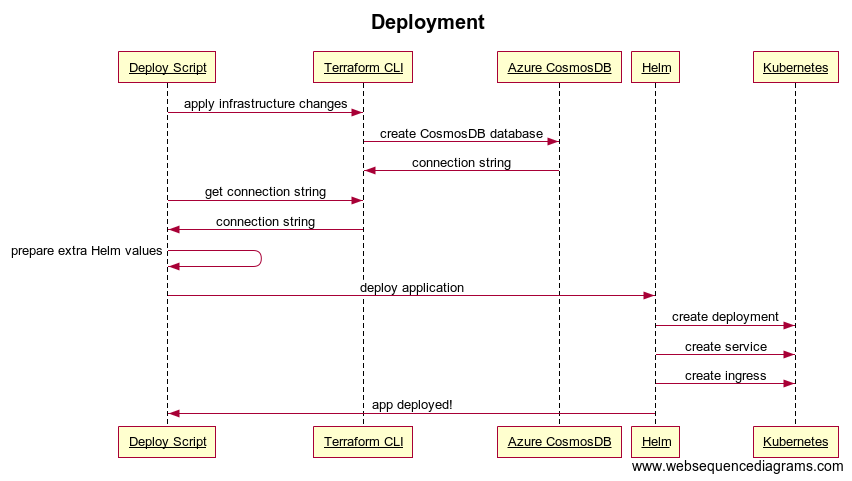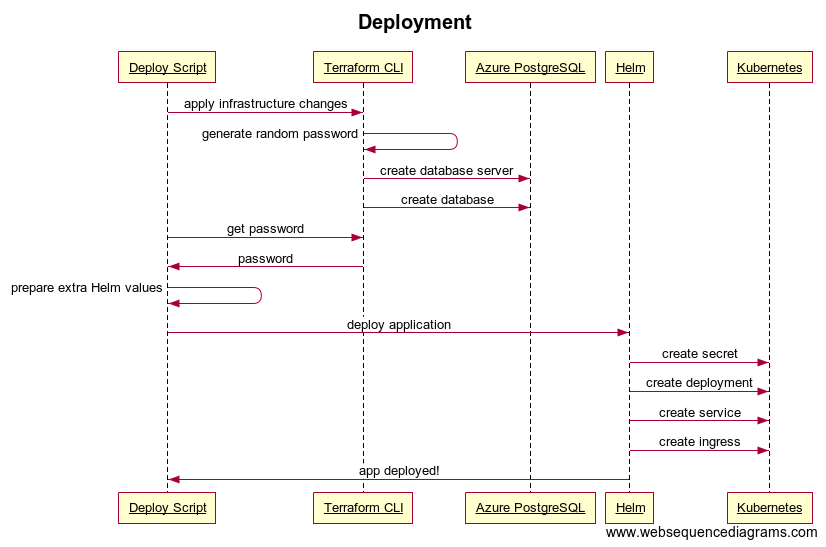In a previous post, I used Terraform and Helm to pass the connection string of an Azure CosmosDB database to the service that needs it without storing it anywhere in between. In this post, I’ll do something similar for a PostgreSQL database and beef up the security a bit.
In the case of CosmosDB, Azure generates the connection string for us. Terraform exposes it as an output. With a bash script, we pass the output to Helm as a supplementary set of values. This ends up as an environment variable to the application at runtime.

For PostgreSQL (still in Azure), we need to tell Azure what username and password we prefer. We want to create the database via Terraform automatically during deployment, so those values have to come from somewhere.
One solution could be to define them as environment variables in the CI server. It can get a bit complicated with supporting different credentials per environment but it’s doable, although a bit messy.
What I tried instead is to let Terraform generate a random password for me. Like I said in the last post, the best secret is the one nobody knows. Here’s how it’s done:
resource "random_string" "db-password" {
length = 16
min_upper = 1
min_lower = 1
min_numeric = 1
min_special = 1
}
This defines a random string resource named db-password. It specifies the
length of the password (16) and also that it needs to consist of at least one
uppercase letter, one lowercase letter, one number and one special character.
We can use it in the definition of the database server:
resource "azurerm_postgresql_server" "acme-db-server" {
[...]
administrator_login_password = "${random_string.db-password.result}"
[...]
}
Terraform will generate the password once and then store it in its state file. So it won’t create a different password on each deployment.
To pass the password to the outside world, we need to define an output (just like in the last post):
output "db_password" {
value = "${azurerm_postgresql_server.acme-db-server.administrator_login_password}"
sensitive = true
}
The sensitive attribute (which I forgot last time) tells Terraform to mask the
password when it’s printing it to the summary of available outputs. This
enhances our security game because now the password will also be hidden from
the build logs.
One small side note on Terraform: read the documentation carefully. Some attributes cannot be changed without destroying and re-creating the resource. Luckily the password is not such a case, but the username is. Be extra careful and always run Terraform first (automatically) to all environments before running it on production.
Back to the random password. We now have a random password and we can pass it all the way to the application running in the Kubernetes cluster via extra values in the Helm deployment. We can also strengthen the security a bit on the Kubernetes side as well by using a Kubernetes secret.
In Helm, we create a new template secret.yaml:
apiVersion: v1
kind: Secret
metadata:
name: for-your-eyes-only
type: Opaque
data:
dbPassword: "{{ .Values.dbPassword | b64enc }}"
and we change the environment variable definition in deployment.yaml to get
the value from the secret:
- name: SPRING_DATASOURCE_PASSWORD
valueFrom:
secretKeyRef:
name: for-your-eyes-only
key: dbPassword
This has no impact to the application (it still reads the same value). It just protects the password from unauthorized eyes. In order to read the value of the secret you need to be authorized by your Kubernetes administrator.

With all these changes we have achieved:
- no passwords in the source code
- no passwords in the build logs
- password generated by Terraform and stored in Terraform state (with controllable access)
- password stored in Kubernetes as a secret (with controllable access)
As long as humans are involved in the process, a password can still leak (if you
will pardon my bias). If that happens, using the Terraform taint command we
can force a new random password to be created on the next deployment.
For me this is already a great improvement on security, but I still like to keep improving. An idea might be to automatically taint the password every N days (or every N deployments). I’m also curious to play with a system like Vault (which comes from the same company as Terraform, HashiCorp).